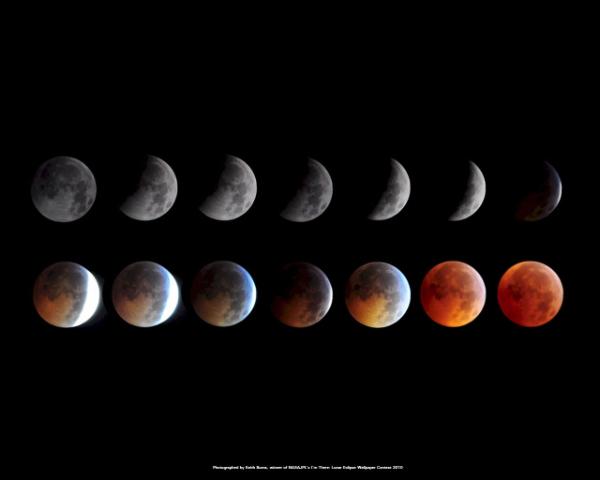Australia and Asia perfectly placed for last Lunar Eclipse of 2014

In Summary
There will be a lunar eclipse on the evening of Wednesday 8 October with Australia and Asia able to see the entire event.
This is the second and last lunar eclipse of 2014 and will begin at 8.15pm AEDT. The entire visible effect of the eclipse will last for 3 hours 20 minutes, with totality occurring from 9.25 – 10.25pm AEDT. The timing of the event across the region is listed below in local times. (The eclipse cannot be observed in India as it takes place before moonrise.:
|
Region |
Eclipse starts |
Total Eclipse |
Eclipse ends |
|---|---|---|---|
|
Vic/NSW/Tas/ACT |
8.15pm |
9.25pm-10.25pm |
11.35pm |
|
Qld |
7.15pm |
8.25pm-9.25pm |
10.35pm |
|
SA |
7.45pm |
8.55pm-9.55pm |
11.05pm |
|
NT |
6.45pm |
7.55pm-8.55pm |
10.05pm |
|
WA* |
6.19pm |
6.25pm-7.25pm |
8.35pm |
|
Cambodia (Phnom Penh)* |
5.42pm (ICT) |
6.00pm-6.25pm |
7.35pm |
|
China (Beijing)* |
5.39pm (CST) |
6.25pm-7.25pm |
8.35pm |
|
China (Hong Kong)* |
5.59pm (HKT) |
6.25pm-7.25pm |
8.35pm |
|
Indonesia (Jakarta)* |
5.42pm (WIB) |
5.55pm-6.25pm |
7.35pm |
|
Japan (Tokyo) |
6.15pm (JST) |
7.25pm-8.25pm |
9.35pm |
|
Malaysia (Kuching)* |
6.24pm (MYT) |
6.25pm-7.25pm |
8.35pm |
|
Malaysia (Kuala Lumpur)* |
6.59pm (MYT) |
7.00pm-7.25pm |
8.35pm |
|
New Zealand (Auckland) |
10.15pm (NZDT) |
11.25pm-12.22am |
1.35am (9 Oct) |
|
Philippines (Manila)* |
5.34 (PHT) |
6.25pm-7.25pm |
8.35pm |
|
Singapore* |
6.51pm (SGT) |
6.55pm-7.25pm |
8.35pm |
|
South Korea (Seoul) |
6.15pm (KST) |
7.25pm-8.25pm |
9.35pm |
|
Thailand (Bangkok)* |
5.59pm (ICT) |
6.00pm-6.25pm |
7.35pm |
|
Vietnam (Hanoi)* |
5.34pm (ICT) |
5.35pm-6.25pm |
7.35pm |
* Regions so far west that the eclipse has already started before moonrise, instead the time of moonrise is given.
Swinburne University of Technology astronomer Dr Alan Duffy says that there are some key aspects of the event to watch out for.
“The eclipse begins with a shadow slowly appearing on the surface of the Moon. This is the Moon passing from the outer edge of our Earth’s shadow, called the penumbra, into the darkest region, the umbra. Over the next hour more of the Moon will be covered until eventually it lies directly behind the Earth away from the Sun.
“At this point the Moon should be blacked-out as the Sun’s light is entirely blocked by the Earth but it will actually appear blood red. This colour is from all the sunrises and sunsets of Earth shining onto the Moon. Our atmosphere bends or scatters the light onto the Moon even though it’s directly behind us. If we had no atmosphere the Moon would be completely invisible at this point.
“The phase of totality with a red moon lasts for an hour, before the Moon begins to leave the umbra and the series of events reverses over the course of the final hour.
“Unlike a Solar Eclipse when the Moon passes between the Sun and the Earth, the Lunar Eclipse is completely safe to view and no special precautions are needed.
“The exact reddish colour of the Moon during totality tells astronomers about the state of our atmosphere, becoming a dull gray colour if there’s been a recent volcanic eruption which has thrown dust high into the air, blocking out the light,” Dr Duffy said.
“If you have any friends who believe in a flat-Earth make sure to point out the shape of the shadow at is passes over the Moon. It will always be curved because the Earth is round, a fact that Aristotle used to prove that the Earth was not flat.”

The lunar eclipse begins with a dark shadow slowly passing over the surface of the Moon, ultimately covering it. Instead of becoming invisible during 'totality' in the eclipse it is illuminated by a red glow from all the sunsets of Earth shining onto the Moon. This sequence was taken during the December 2010 lunar eclipse and will be very similar to what regions in Australia and Asia will see on Wednesday 8 October. Image credit: NASA / Keith Burns.
Check the eclipse prediction by NASA here.
For more information please contact Dr Alan Duffy on Twitter: @astroduff Web: www.alanrduffy.com

